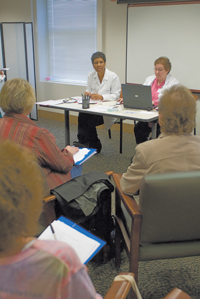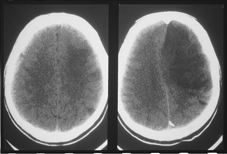Shared visits improve access, productivity and satisfaction
Shared office visits provide groups of patients with more time with their doctors, not less, and come under the rubric of smart care. Learn how leading institutions have adopted them.
At a shared medical visit for a dozen of her patients, Karen DaSilva, MD, saw one of her more reticent patients open up while discussing her cancer diagnosis, received two days earlier.
“She had come for treatment for low sodium, a condition related to her cancer,” said Dr. DaSilva, who is interim director of internal medicine at Harvard Vanguard Medical Associates, a Massachusetts-based multi-specialty group practice of more than 600 physicians that has launched more than 25 shared medical appointments in the past year and plans to launch another 30 in the coming one.

“As she told her story, the man sitting next to her, who had come in with a sprained ankle, revealed he'd had myeloma years earlier,” Dr. DaSilva continued. “They talked about the kinds of questions she should ask her oncologist on the first visit, and what it's like to put your life in the hands of a doctor you don't know. I almost felt like an eavesdropper.”
Patients teaching, supporting and encouraging one another is one of the hallmarks of shared visits, say many physicians who have adopted this paradigm of care. Shared visits, or group visits, are physician office visits, typically 90 minutes, in which a group of seven to 15 patients receive one-on-one care in the presence of other patients. Each patient may bring a companion, and all must sign confidentiality forms. Patients may be grouped by age, sex or medical condition, or the group may be heterogeneous.
Group visits are billed as regular office visits, and are accepted by Medicare and private insurers. Developed more than 15 years ago, group visits are now gaining visibility as a way to improve access to care, particularly in areas like Massachusetts, where primary care physicians grapple with long backlogs of patients waiting for appointments.
“I have to admit that I was a little nervous going into it. It's a different way to deliver care, and I was concerned about how my patients might react,” said Dr. DaSilva. “As it turns out, most of them love it.”
Many patients appreciate having 90 minutes with the doctor. Instead of a quick 15-minute private visit, they can get into a broad and deep group discussion. Dr. DaSilva collects written surveys after every group visit. One of her patients recently commented, “I usually hate going to the doctor, but this was the most fantastic doctor's visit of my life.”
“This comes under the rubric of smart care,” said Allan H. Goroll, MACP, professor of medicine at Harvard Medical School and a former ACP Governor for Massachusetts. “Joint visits are absolutely essential to opening up access in any delivery system. They're very effective, patients like them and they don't preclude having a one-on-one. Throughout Massachusetts and throughout the country, shared visits are becoming a standard part of practice transformation.”
Continuity, drop-in models
While shared visits can be structured in a number of ways, a few distinct models have gained broad acceptance. All can be used in a capitated or fee-for-service setting.
John C. Scott, FACP, associate professor of medicine and geriatrics at the University of Colorado in Denver, developed the cooperative health care clinic (CHCC) model in 1991 while at Kaiser Permanente. “I was seeing a lot of geriatric patients, and at the end of every visit I could look in the patient's eyes and see that they had other issues they wanted to talk about, but I didn't have any more time,” said Dr. Scott.
He established a group attended each month by the same 15 to 20 high-use geriatric patients. Each 2.5-hour session included:
- a 15-minute period for introductions and socialization,
- group discussion and education on issues such as coronary disease, falls and dementia,
- one-on-one care (provided by Dr. Scott and a nurse) that did not require disrobing, such as blood pressure checks, ordering laboratory tests and answering questions, and
- additional time with Dr. Scott after the group meeting for any patient needing further care in a private setting.
Two randomized clinical trials published in the Journal of the American Geriatrics Society (1997 May; 45(5):543-9 and 2004 Sep; 52(9):1463-70) showed that compared to the traditional private visit, the CHCC resulted in lower costs, better outcome, higher patient and physician satisfaction, 12% less hospitalization and 18% less use of the emergency room, Dr. Scott said. However, because the CHCC model requires 2.5 hours of physician time, it does not increase physician efficiency or improve access to care for the more than 2,000 patients in the practice.
Two additional group visit models were developed by psychologist Edward Noffsinger, PhD, vice president of shared medical appointments and group-based disease management at Harvard Vanguard. Dr. Noffsinger suffered from a severe cardiopulmonary condition in the late 1980s and early 1990s, while he was director of oncology counseling and chronic illness services at Kaiser Permanente in Santa Clara, Calif. Frustrated by how long it took to schedule individual office visits, he wanted more time with his doctors and a less rushed pace of care; he wanted more patient education and disease self-management skills, and he wanted to integrate the help and support of other patients (plus a multidisciplinary care delivery team) into his health care.
So, he developed and launched the drop-in group medical appointment (DIGMA) model, followed by the shared medical appointment (SMA) model for physical examinations.
Dr. Noffsinger's DIGMA and SMA shared visit models last 90 minutes and are held weekly, although they can be held as often as every day of the week. Each one typically increases the physician's overall productivity by 8-10% for a full time internist, and twice that for one who is half-time. Though patients are educated through group discussion and patient-doctor conversations, shared visits differ from educational sessions, behavioral medicine programs, and support groups in that patients receive one-on-one medical care from their physicians in the highly supportive group setting.
A DIGMA (usually 10 to 15 patients) may focus on one chronic disease or condition, such as diabetes; one type of patient, such as males over age 50; or it may be open to any established patient who needs follow-up care.
SMAs for physical exams in internal medicine are single-gender groups of six to eight female, or seven to nine male, patients. Both types of groups are typically designed to dramatically increase the physician's productivity and have different patients in attendance each week (as patients only come in when they have an actual medical need), though patients can return to a DIGMA as needed.
DIGMAs and SMAs typically provide a specifically trained documenter to do chart notes, a behaviorist to manage the group dynamics and address psychosocial issues and a nurse and/or medical assistant with expanded duties.
Patient, physician benefits
Physicians who conduct shared visits have cited higher patient satisfaction, improved access and better quality of care as the key patient benefits.
Richard A. Maxwell, MD, a Wooster, Ohio-based pediatrician, is director of the Cleveland Clinic Foundation's Shared Medical Appointment Project started in 2002 by David Bronson, FACP, a former chair of ACP's Board of Governors.
Patients can teach one another because they have unique information to offer from their own experiences, from which the entire group benefits. As a result, Dr. Maxwell said, about 85% of patients who try an SMA say they prefer that format for their next appointment.
Some people just don't feel comfortable sharing personal information in groups, so for those patients the private visit is more appropriate. But it's not who you'd think; patients with sensitive issues such as erectile dysfunction may be more comfortable in a group setting than in a private visit, possibly because the group discussion is less rushed, and someone else may bring up the problem first, Dr. Maxwell said.
Dr. Maxwell has taught more than 40 Cleveland Clinic physicians how to establish shared visits. He said that on average, physicians who conducted shared visits reduced the time to their third available private appointment from 40 days out to 18 days out, and were usually able to see patients in a shared appointment within one week. (The main measure of access is third available appointment because the first available appointment may only reflect a cancelled slot and not actual access. The third open slot suggests true provider availability.)
“That alone, arguably, improves the quality of medicine that you deliver,” he said. “If your patient has a problem and can't see you for six to eight weeks for a follow-up, there's a good chance he'll be in worse shape than if he came in within two or three days.”
Physicians using shared visits can improve their productivity by three-fold or more for each DIGMA that they run, Dr. Noffsinger said, accomplishing in 90 minutes what would take 4.5 hours if they saw patients individually.
The increased productivity could enhance revenue, although Dr. Maxwell said many physicians use the extra time for teaching and research.
Smaller practices may face special challenges in establishing shared visits, such as finding a room large enough to accommodate the group, or having the support staff necessary to facilitate discussions and document one-on-one care. Some individual practitioners conduct their groups outside of regular office hours and convert their waiting rooms into group space, Dr. Noffsinger said. He offers detailed how-to information for setting up group visits in his book, Running Group Visits in Your Practice, which was published this year by Springer.
“The larger health care systems did them first, followed by mid-sized systems, the VA and Department of Defense, and finally systems in the public health sector,” Dr. Noffsinger said. “However, we're seeing many smaller practices do them successfully even with limited resources.”




